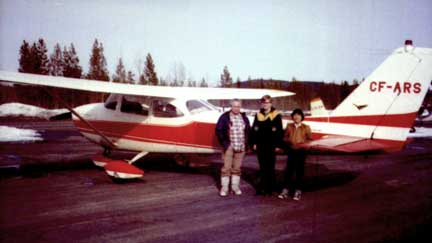 |
|
Mountain Tops |
| FTLComm - Watson Lake Yukon - Friday, December 7, 2001 |
 The pictures that appear on this page were taken North West of Watson Lake on April 2, 1984. Harvey Shields was leading the newly formed Watson Lake air cadets and two (Eric Bonnett and Danny Deck) had been selected to go with me for a plane ride over their own back yard. The flight aboard my Cessna Skyhawk 172, ARS lasted for one hour and twenty-four minutes as we climbed above the |
 |
 mountain tops to the North of the airport and winged our way over 6,800 foot mountains. From the ground the surrounding trees and perspective hide the spectacle of the peaks and domes that populate an alpine wilderness. But in the air in a docile 172 you can float around them and see what few have ever seen. (See safety note at the bottom of this story) Shortly after first beginning our flights over the mountains we contemplated the nasty fact that an engine could fail and that got us to thinking. Ravens land on power poles by entering and shallow dive lined up two feet below the pole's top, then they climb sharply apply a flap and arrest forward movement with the climbing stall. They are great at it and I and my sons decided this was the maneuver for an emergency landing in mountainous terrain. So if you ever have to do it, better practice. We spent a lot of flights practicing the Raven landing over nice smooth domed top mountains always practicing to complete the action two hundred feet above the top. One afternoon with the Raven landing down pat I came over a top at right around a |
 |
 hundred feet and sharp eyed Andrew spotted a hole and that was how we discovered limestone caves in one set of mountain tops. But the tops you see here are much further North and as you can see pretty nasty. Most of these images are taken out of the pilot's side looking West toward the Rancheria ranch. A highly mineralised area that a couple years later would actually see a mine develop on a highland plateau. |
 One of the amazing things about flying over these features is the overwhelming feeling of the bigness of the country side and how there is no one nor any evidence of people ever having been there. Of course this is an illusion. Prospectors have climbed all over these things for almost a century and every so often we would spot a neat cairn on a top placed there by the United States Core of Engineers when developing the Alaskan Highway or by a bored helicopter pilot waiting to pick up a survey party. One such pilot was a neighbour of ours who one busy day set down on a mountain top to make a high level pit stop. He left his Bell Jetranger idling and stepped out on a skid. The blade was lazily flapping around when a gust caught it and our neighbour was tossed off the skid and two million dollars worth of Jetranger was turned into future Reynolds wrap as it tumbled down the slope. Embarrassment, a long session with insurance adjusters and everyone was please that only the metal was damaged |
 |
| Safety Note: By the time these pictures were taken I had accumulated more that three hundred hours of mountain flying and learned some of the cardinal rules. Mountain tops are dangerous, even on a calm day there will be a good flow over the top so you have to be very aware of wind direction because on the lee side the down draft will exceed your aircraft's climb rate. On the windward side maintain a wide separation from the crest and when ever possible do so in a climbing turn into the wind. Under no circumstance approach a cirque perpendicular to the bowl, always cross diagonally so that you can dive and bank away if caught in a down draft Maintain clearance over the tops of a least two hundred feet anything closer is a death wish. For a safe flight avoid any and all abrupt maneuvers, gentle turns, cruise power and minimum climbs and descents. Above all do not let your own enthusiasm or that of your passengers get out of control as you want to be able to repeat a trip like this. |